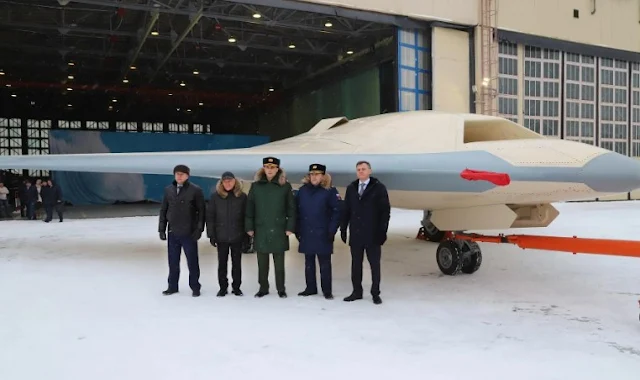 |
| United Aircraft Corporation Rolls Out First Flight Prototype of Okhotnik Heavy Strike Drone |
International Military - Russia welcomes the update of one of its iconic weapons. Recently, Russia's S-70 Okhotnik-B drone was reported to have received a substantial upgrade to its stealth capabilities. Often envisioned by the Russian defense industry and military leaders as the keystone of the future technologically advanced Russian Air Force, the Okhotnik-B shares many of the characteristics of the future-oriented Su-57 multirole aircraft.
With the unmanned aerial combat vehicle (UCAV) currently in development and likely far from serial production, the real move to improve the stealth capabilities of the Okhotnik-B could suggest that development remains flexible.
Much of what outside observers know about the S-70 is based largely on information maintained from outside Russia on the project.
According to Russian state media, the Okhotnik-B or Hunter-B with the English translation of its Russian name, is a flying-wing drone reportedly capable of traveling at speeds of up to 1,000 kilometers per hour.
Reporting from 19fortyfive.com in the article entitled 'Russian S-70 Okhotnik-B Stealth Drone: A True Game-Changer?', the exact nature of the S-70's equipment is unknown. However, the drone appears to have a fully internal weapons bay to carry its weapons payload.
While early versions of the drone were powered by a single Saturn Al-41F1 engine, external observers have noted that the exposed engine exhaust configuration without the shroud would naturally hinder its ability to remain silent as intended.
Publicly released drone videos have featured visible radar and camera arrays, but little is known about the exact nature of these systems.
Development of the S-70 Okhotnik-B reportedly began in 2011 when the Sukhoi Aircraft Company received a contract from the Ministry of Defense to develop a heavy attack drone that might match the development of American analog drones being developed by Lockheed Martin and Boeing.
With its first highly publicized flight in August 2019, development of the S-70 has been closely linked to the development of the fifth-generation Su-57 multirole aircraft, which shares a large number of components.
In particular, experts such as Joseph Trevithick and Michael Kofman have speculated that the Okhotnik-B was designed to serve as a 'loyal officer' of the Su-57 through connection with the advanced computing systems allegedly included in the Su-57 as part of it. its intended role as a network-centric fifth-generation aircraft.
However, it looks like the Russian Su-57 has yet to achieve that capability. Perhaps to better fulfill its complementary role to the Su-57 more effectively or simply to reduce its radar signature, Russia unveiled an updated version of the S-70 with some seemingly integrated adjustments to enhance its stealth capabilities.
In particular, the Okhotnik-B revealed at the Novosibirsk Aircraft Production Association in December 2021 includes a new nozzle for the rear engine exhaust that emphasizes stealth above all else. Other elements of the drone's exterior have been simplified or eliminated, such as the antennas, exhaust vents and air intakes.
During his visit to the Novosibirsk facility, Russian Deputy Defense Minister Alexei Krivoruchko claimed that the S-70 could operate independently and in groups, possibly referring to its hypothetical role as the Su-57, the so-called loyal wingman of the Su-57.
As the S-70 UCAV appears to be progressing towards the end of its development, outside observers have raised questions about future drone production and delivery.
As the director general of state-owned holding company Sukhoi United Aircraft Corporation Yury Slyusar pointed out in an August 2020 meeting with Russian President Vladimir Putin, deliveries of the Okhotnik-B are supposed to start in 2024.
While this official deadline is still two years away, there is no guarantee that it will be met, as the Okhotnik-B is just as vulnerable to getting caught up in stop-and-go Russian defense procurement and development as any new system.
The Russian defense industry appears to have no problem with the technical know-how needed to tackle the S-70's stealth and other capabilities.
However, the real test will be whether the UCAV can be produced at a useful scale and integrated into the Russian Aerospace Forces effectively alongside next-generation systems.
Some time ago, the United States (US) media would say that Moscow now has one of the most advanced drones in the world. The second prototype of this combat drone is named the Sukhoi S-70 Okhotnik which was recently launched by the United Aircraft Corporation (UAC) of Russia.
Quoted from Aerotime.aero, in August 2019 UAC revealed that the final design of the vehicle would feature a flat exhaust nozzle, a feature that should reduce radar and infrared signatures. This feature was also present on several previous American and Russian test aircraft as well as the Lockheed Martin F-22 Raptor fighter jet.
According to UAC, serial production of the drones will begin in 2024, with first deliveries expected later that same year.
